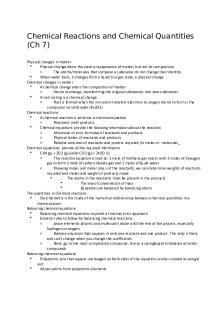Master SQL Exp 5 Rates of Chemical Reactions - Iodination of Acetone PDF

| Title | Master SQL Exp 5 Rates of Chemical Reactions - Iodination of Acetone |
|---|---|
| Course | General Chemistry Recitation/Laboratory |
| Institution | New Jersey City University |
| Pages | 2 |
| File Size | 52.6 KB |
| File Type | |
| Total Downloads | 109 |
| Total Views | 151 |
Summary
tied with lab...
Description
LABORATORY REPORT PREPARATION GUIDE
MASTER SQL Experiment 5 Rates of Chemical Reactions: Iodination of Acetone I. Introduction
1. What is the rate of a chemical reaction and what are the factors that affect the reaction rate? 2. What does the rate law represent when in it comes to determining the effect of concentration on the rate of reaction? 3. What do the order of reaction and rate constant indicate in the rate law? 4. What were the objectives of this experiment? 5. Which chemical reaction was performed and what data were collected to achieve these objectives? 6. How did you plan the data collection in order to determine the effect of concentration on the reaction rate? 7. What were the hazards in this experiment and what safety precautions did you implement to minimize the risk of these hazards?
II. Results Analysis
A. Data and Calculations
Summarize the important results in this section or refer the reader where they are presented in this report.
B. Discussion
1. What happens during iodination reaction? Show the balanced reaction equation. 2. What was the role of iodine, acetone, and hydrochloric acid in the reaction? 3. How many reactions were performed and which reactant concentrations did you vary in these reactions? 4. Why did you vary these concentrations? 5. What change was observed when the reaction has reached completion and what did the times recorded for this change indicate?
6. Why was it necessary to change the concentration of reactants and to follow the proper sequence of adding the reactants? 7. How was the order of reaction with respect to each reactant determined using the initial rates method? Briefly explain with calculations. 8. What is the order of reaction with respect to the concentration of each reactant? 9. What do these orders of reaction indicate with respect to the overall rate of the iodination reaction? 10. How was the rate constant of each reaction trial determined and what was the average rate constant of the reaction? 11. Why was it important to report the temperature the rate constant was obtained?
III. Conclusions
1. Based on the visual observation of the rate of the reaction and calculated orders of reaction with respect to each reactant, what can you conclude from the effect of changing concentration on the rate of iodination reactions? Support your conclusion with concrete evidence from gathered time data and by comparing the initial rates of various trials. 2. From the calculated rate constants, what can you conclude from the effect of changing concentration of reactants on the rate constant? 3. Were the expected results achieved? If not, what were the possible causes of error and what could have been done to avoid them? 4. Why is chemical reaction rates important in chemistry? Give one practical application....
Similar Free PDFs

Rates of Chemical Reactions
- 9 Pages

Rates of chemical reaction
- 5 Pages

Types of chemical reactions
- 4 Pages

Kinetics - Bromation of Acetone
- 3 Pages

Tutorial 5 basics of sql
- 8 Pages
Popular Institutions
- Tinajero National High School - Annex
- Politeknik Caltex Riau
- Yokohama City University
- SGT University
- University of Al-Qadisiyah
- Divine Word College of Vigan
- Techniek College Rotterdam
- Universidade de Santiago
- Universiti Teknologi MARA Cawangan Johor Kampus Pasir Gudang
- Poltekkes Kemenkes Yogyakarta
- Baguio City National High School
- Colegio san marcos
- preparatoria uno
- Centro de Bachillerato Tecnológico Industrial y de Servicios No. 107
- Dalian Maritime University
- Quang Trung Secondary School
- Colegio Tecnológico en Informática
- Corporación Regional de Educación Superior
- Grupo CEDVA
- Dar Al Uloom University
- Centro de Estudios Preuniversitarios de la Universidad Nacional de Ingeniería
- 上智大学
- Aakash International School, Nuna Majara
- San Felipe Neri Catholic School
- Kang Chiao International School - New Taipei City
- Misamis Occidental National High School
- Institución Educativa Escuela Normal Juan Ladrilleros
- Kolehiyo ng Pantukan
- Batanes State College
- Instituto Continental
- Sekolah Menengah Kejuruan Kesehatan Kaltara (Tarakan)
- Colegio de La Inmaculada Concepcion - Cebu










